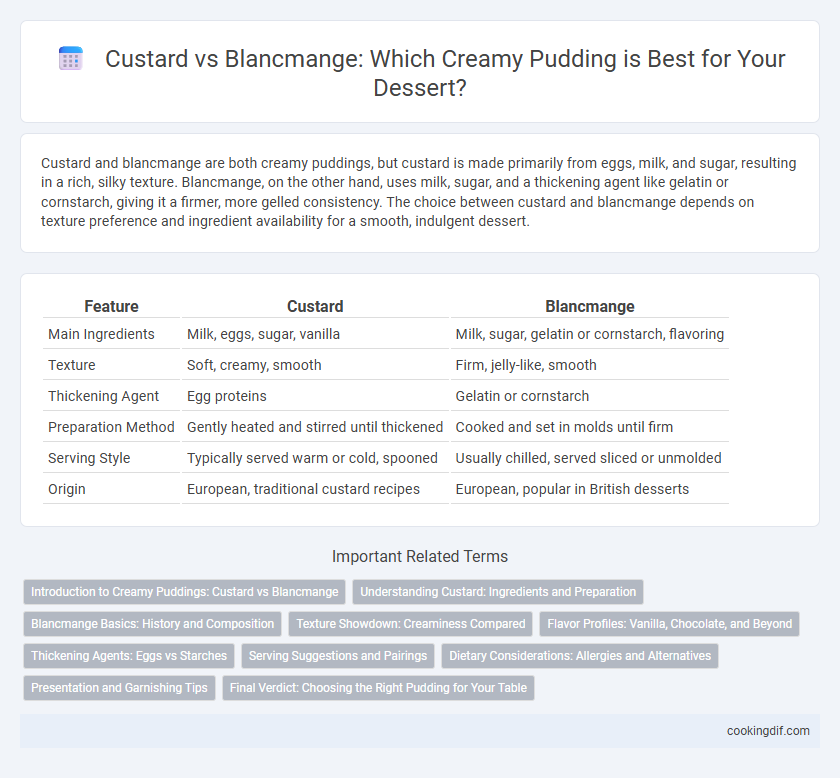Custard and blancmange are both creamy puddings, but custard is made primarily from eggs, milk, and sugar, resulting in a rich, silky texture. Blancmange, on the other hand, uses milk, sugar, and a thickening agent like gelatin or cornstarch, giving it a firmer, more gelled consistency. The choice between custard and blancmange depends on texture preference and ingredient availability for a smooth, indulgent dessert.
Table of Comparison
| Feature | Custard | Blancmange |
|---|---|---|
| Main Ingredients | Milk, eggs, sugar, vanilla | Milk, sugar, gelatin or cornstarch, flavoring |
| Texture | Soft, creamy, smooth | Firm, jelly-like, smooth |
| Thickening Agent | Egg proteins | Gelatin or cornstarch |
| Preparation Method | Gently heated and stirred until thickened | Cooked and set in molds until firm |
| Serving Style | Typically served warm or cold, spooned | Usually chilled, served sliced or unmolded |
| Origin | European, traditional custard recipes | European, popular in British desserts |
Introduction to Creamy Puddings: Custard vs Blancmange
Custard and blancmange are two classic creamy puddings that differ in ingredients and texture. Custard is traditionally made from eggs, milk, and sugar, yielding a rich, silky consistency, while blancmange uses milk, sugar, and gelatin or cornstarch for a firmer, smoother texture. Both desserts offer versatile flavor profiles and have deep roots in European culinary history, making them popular choices for creamy pudding lovers.
Understanding Custard: Ingredients and Preparation
Custard, a classic creamy pudding, is primarily made from a blend of milk or cream, egg yolks, sugar, and vanilla, which creates its rich texture and smooth consistency. The preparation involves gently heating the mixture while continuously stirring to prevent curdling and achieve a silky finish. Unlike blancmange, custard relies on egg proteins for thickening rather than gelatin, resulting in a velvet-like mouthfeel that highlights its custard-specific ingredients and technique.
Blancmange Basics: History and Composition
Blancmange is a classic creamy pudding with origins tracing back to medieval Europe, traditionally made from milk or cream, sugar, and thickened with gelatin or cornstarch. Unlike custard, which relies on egg yolks for its smooth texture, blancmange achieves its signature silky consistency through starch-based thickening agents, making it a popular choice for those seeking a dairy-rich but egg-free dessert. Its versatility allows for various flavorings such as vanilla, almonds, or fruit extracts, sustaining its longstanding appeal in European dessert cuisine.
Texture Showdown: Creaminess Compared
Custard offers a velvety, smooth texture achieved through the gentle cooking of egg yolks, resulting in a rich and creamy mouthfeel. Blancmange, typically set with gelatin or cornstarch, presents a firmer, jelly-like consistency that is lighter and slightly springier. The creaminess of custard is more luscious and dense, while blancmange provides a delicate silkiness that holds its shape more distinctly.
Flavor Profiles: Vanilla, Chocolate, and Beyond
Custard offers a rich, velvety texture with classic vanilla and chocolate flavors that provide a warm, comforting taste experience, while blancmange features a lighter, gelatinous consistency with subtle sweetness, often infused with almond or fruit essences for added complexity. Vanilla custard delivers intense creaminess with deep vanilla bean notes, whereas blancmange's flavor profile can range from delicate floral tones to vibrant citrus hints, making it versatile for various palate preferences. Chocolate custard provides a bold, decadent richness contrasted by blancmange's milder, creamy base that allows complementary flavors like coconut or spices to shine.
Thickening Agents: Eggs vs Starches
Custard relies on eggs as its primary thickening agent, which coagulate when heated to create a rich, creamy texture with a delicate flavor. Blancmange, on the other hand, uses starches such as cornstarch or gelatin to thicken, resulting in a smoother, slightly firmer consistency with a more neutral taste. Understanding these differences in thickening agents is essential for achieving the desired texture and flavor profile in creamy pudding desserts.
Serving Suggestions and Pairings
Custard pairs well with fresh berries, caramel sauce, or a sprinkle of nutmeg, enhancing its rich, creamy texture. Blancmange is often served chilled with fruit compotes, citrus zests, or a drizzle of raspberry coulis to complement its smooth, gelatin-based consistency. Both puddings benefit from light, tart accompaniments that balance their sweetness and creamy mouthfeel.
Dietary Considerations: Allergies and Alternatives
Custard typically contains eggs and dairy, making it unsuitable for those with egg or lactose allergies, whereas blancmange is often made with milk and thickening agents like cornstarch, offering a potential alternative for egg-allergic individuals but still posing challenges for lactose intolerance. Vegan and dairy-free versions of blancmange utilize plant-based milk such as almond or coconut, catering to dairy-free diets, while custard alternatives generally require specialized egg substitutes to maintain creaminess. Allergy-conscious consumers should carefully check ingredient lists and consider allergen-free alternatives like coconut milk blancmange or egg-free custard to accommodate dietary restrictions.
Presentation and Garnishing Tips
Custard offers a smooth, glossy finish that pairs beautifully with a sprinkle of nutmeg or fresh berries for vibrant color contrast. Blancmange presents a firmer texture, ideal for intricate molds and decorated with toasted almonds or a drizzle of fruit coulis to enhance elegance. Garnishing custard with edible flowers elevates presentation, while blancmange benefits from a dusting of powdered sugar to highlight its delicate contours.
Final Verdict: Choosing the Right Pudding for Your Table
Custard offers a rich, velvety texture with a pronounced egg flavor, making it ideal for those who appreciate traditional, indulgent creaminess. Blancmange provides a lighter, subtly sweet alternative with a smooth gel-like consistency, perfect for versatile dessert options and dietary preferences such as gelatin-free. Selecting between custard and blancmange depends on desired richness and texture, with custard favored for depth and blancmange for delicate, customizable creaminess.
Custard vs Blancmange for creamy puddings Infographic

 cookingdif.com
cookingdif.com